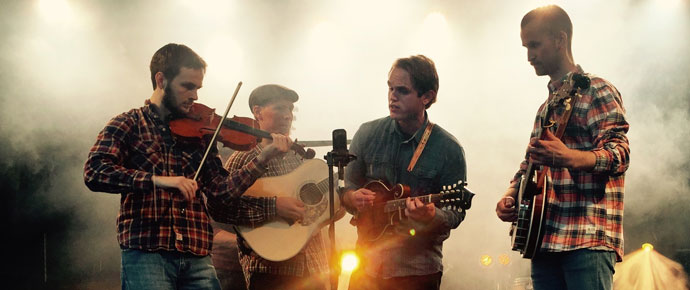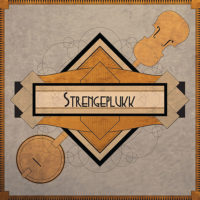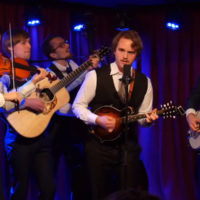
The name Strengeplukk doesn’t exactly roll off the tongue. However the same can’t be said for the music Strengeplukk’s been plying in their native Norway since 2015. Founded by Jakob Folke Ossum (guitar), Nikolai Storevik (fiddle), and Andreas B. Onarheim (mandolin), the band later enlisted Thorbjørn André Bilstad Olsen and Lasse Gjestrud on banjo and bass respectively. Gjestrud left in autumn 2016 and was replaced by Vidar Starheimsæter. Three years later, the band continues to carry on, mining a blend of traditional tunes plucked from the American bluegrass songbook and original compositions utilizing their highly tuned harmonies and instrumental acumen.
The band is based in their hometown of Stavanger, Norway, but for the past three years they’ve toured the country while frequenting the festival scene. To date, they’ve recorded an EP, followed by the release of their debut album Fjellvegen in 2018.
The band members recently agreed to share their influences and insights. Here, in their own words, are their reasons why they became bewitched by bluegrass.
For starters, can each of you share the reasons you were drawn to this particular idiom?
Thorbjørn: For me, it was definitely the banjo. I was struggling with my technique on the guitar, trying to get the style of country and chicken picking. At some point I was trying to learn a guitar arrangement of Foggy Mountain Breakdown, and at that time I figured I’d just borrow a 5-string for the heck of it. Needless to say, I learned to practice through picking up the banjo. Then my focus shifted pretty quickly from country to bluegrass, the latter being the more banjo-heavy genre of the two. I think Doc & Merle’s Home Sweet Home was the first bluegrass album I really wore out on my stereo. After that, I discovered Alison Krauss, Flatt & Scruggs, and Nitty Gritty Dirt Band. Will the Circle Be Unbroken was the album that really gave me the feel that bluegrass is a really social and inclusive kind of music. I have been playing the banjo for six years now, and my influences have changed a lot over that time, shifting back and forth between the traditional and the more modern. I always return to the Bluegrass Album Band and the Punch Brothers. I also watch a lot of banjo videos on YouTube, which offers the opportunity to really zoom in on one instrumentalist. I have probably seen every video there is to see that features Noam Pikelny, although I hope someone can please prove me wrong.
Jakob: I was starting my second year at the University of Stavanger, studying jazz guitar, and I was kind of searching for some fresh music to add to my musical repertoire, and also trying to find some new inspiration. I was checking out country and chicken picking stuff on the guitar. I was already playing a lot of jazz music together with Nikolai but I was just starting to get into bluegrass, and he taught me a couple of fiddle tunes. Then the ball just started rolling. When I heard Bryan Sutton, I was simply amazed. Then Tony Rice, Doc Watson, David Grier, and Michael Daves sealed the deal.
Nikolai: I was inspired to look into bluegrass after watching a concert performed by Thorbjørn’s and Andreas’ first bluegrass band. I then started listening to artists like Tony Rice, Sam Bush, Jerry Douglas, Bela Fleck, and Mark O’Connor. Because of my background in Norwegian folk music, and my jazz music studies at the University of Stavanger, it didn’t take long to learn the musical language of bluegrass. Jakob and I jammed a lot together at the time, everything from jazz standards to free improvised music, but we soon started playing more and more bluegrass.
Andreas: Before Thorbjørn introduced me to bluegrass, I didn’t have any relationship to the genre, other than that I knew it existed. He introduced me to everything from Punch Brothers to Bill Monroe.
Is bluegrass unique in your country?
Thorbjørn: I would say yes, pretty unique. There are probably two handfuls of serious and active bluegrass bands now, and they are all pretty underground, except Øystein Sunde, who is a well known artist among most Norwegians, and responsible for writing many hit songs. He has an album named Kjekt å Ha which actually features Béla Fleck, Mark O’Connor, and Jerry Douglas. These days, there is also an Americana wave in our popular music culture, and hopefully bluegrass isn’t too far away.
Nikolai: There are some bands that are more or less influenced by bluegrass, but only a few that really study the tradition.
Jakob: I think the bluegrass scene in Norway has grown a lot over the past 10 to 15 years or so. The movie O Brother, Where Art Thou probably had some effect.
Is there any connection between bluegrass and the folk music that is native to Norway?
Nikolai: In my Masters thesis in music performance, the goal was to write music that contained elements from both Norwegian folk music and bluegrass. So I had to study the history of both genres. There is no direct connection between the genres until more recently, when some Norwegian folk musicians began picking up some bluegrass in their music. There is a historical connection to the extent that both genres have roots in European folk music. A fairly small part of the Norwegian folk music is influenced by the folk music on the British Isles, so there is a little connection there. Other than that, the folk music from the British Isles and the Norwegian folk music have both been influenced by folk music and dance trends from the European continent throughout history. There is little documentation of the impact Norwegian folk has had on the folk music from the British Isles and vice versa, but there might be some, considering that Norway and Great Britain have been connected through trade. When it comes to the impact Norwegian folk has had on the American folk music, it is not very likely there has been any at all, considering that the Norwegian fiddlers that emigrated to the US didn’t settle in Appalachia, but rather in states like Wisconsin, Iowa, Minnesota, and North and South Dakota. It should be mentioned though that the West Norwegian fiddle style and the old-time fiddle style do have some technical similarities in that they both use a lot of drone notes. The tunes are in major keys, and the dance music has a lot of rhythmical drive. I think the biggest difference in the melodic language between the genres lies in the African influence on American folk music — blues, pentatonic scales, syncopated rhythms, and, of course banjos — something which Norwegian folk music hasn’t had at all.
What has been the audience reaction to yourmusic?
Thorbjørn: It is mostly very positive. People usually think it is exciting and new, as well as familiar and relatable. And they very much like the one-mic setup!
Andreas: The reaction is often, “I never knew I liked bluegrass this much.”
Nikolai: Norway has a high number of bands and artists relative to its number of inhabitants, and because of that, it’s hard to stand out. But because bluegrass is still so unique in Norway, I believe we have successfully introduced the genre to a lot of new people. Many are fascinated and intrigued by the upbeat tempos, the unusual lyrics about jealousy and murder, and the three-part harmonies. And many people like how we combine traditional bluegrass tunes, more Norwegian folk music-inspired tunes, and also more progressive tunes. This leads people to compare our music to genres that are more common in Norway, like Norwegian folk music, country, singer-songwriter styles, jazz, and Irish folk music. In that way, more people relate to the music.
Jakob: I also feel that the audience is very positive towards our mix of musical genres in our music. This is probably a result of our diverse musical backgrounds, coming from genres such as jazz, rock, country, jazz fusion, and Norwegian folk music.
Where have you performed? Have you been to the States?
Thorbjørn: As of now, we have covered a large part of southern Norway, as well as Longyearbyen (Svalbard). We have also been to Copenhagen, Prague, and at the festival previously known as European World of Bluegrass (EWOB) in Voorthuizen, Netherlands.
Nikolai: We have also been touring many of the same cities along the western coast of Norway for three years in a row now, so the route has become a tradition!
Jakob: We haven’t been to the States yet, unfortunately. As the lyrics in one of Andreas’ songs – Over Dammen (translated: Across the Pond) goes: “To Kentucky, to Tennessee, that’s the dream, that’s where we want to be, but for that we need money.” So, if we go to the states, this song will become invalid, and we won’t be able to play it anymore. We would really like to go soon.
Have you had a chance to play with any notable musicians from the bluegrass world?
Thorbjørn: Last year we got to jam with Jeff Scroggins & Colorado at the Norwegian bluegrass festival, Strenger i Gress, where they spent the week tutoring and performing. This year, at the same festival, I picked a handful of tunes together with Thomas Haglund, who was Jimmy Martin’s fiddler from ‘76 to ‘78. Also, our bass player, Vidar, got to jam with Sierra Hull, Pete Rowan, Rob Ickes, and Trey Hensley on stage when we attended luthier Rosta Capek’s and Ivana Capkova’s wedding in the spring of 2018.
Nikolai: Jakob and I have been lucky enough to get to jam with the musicians of Special Consensus as well. That session, and the sessions with Jeff Scroggins & Colorado, have been some of my best musical experiences so far. Hoping for many more!
Jakob: I also got to pick a few tunes with Brennen Leigh and Noel McKay at this years Strenger i Gress festival. Great musicians and really inspiring!
To sum up, why do you think bluegrass has such worldwide appeal?
Nikolai: I think the reason for the genre’s popularity among musicians is because the music can be performed on different skill levels, and it can still provide a feeling of challenge, a sense of achievement, and a joy of playing together with other people.
Andreas: The music is theoretically easy to understand, and amateurs and professionals can jam together, without any difference in skill levels being a problem. The one-mic setup, which we use, also gives the “wow-factor” to the audience. People say that it makes our performance look playful and action-packed.
Jakob: Besides, how can one not like the banjo?!










